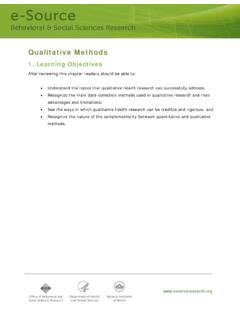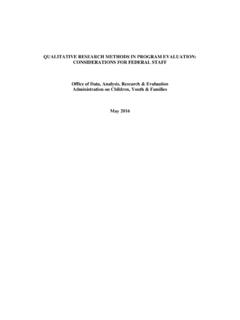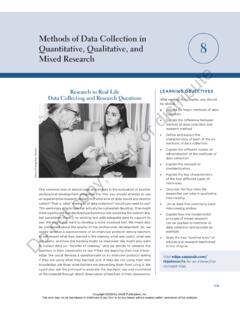Transcription of Research Methods: Qualitative Data Analysis
1 Research methods : Qualitative Data Analysis By Gail Fann Thomas, Associate Professor Graduate School of Business & Public Policy Naval Postgraduate School Chances are you've chosen a Qualitative approach because you wanted to interview key informants, use focus groups to learn about a social phenomenon, or analyze critical documents associated with an important issue. Now let's suppose you've collected your data, but you're not sure how to go about analyzing it. This module will help you start the process by giving you a few simple guidelines. Once you've completed this module, you'll be ready to sit down and start analyzing your own data. As you'll soon find out, Qualitative Analysis is quite different from quantitative or statistical Analysis . Yet, if done well, the process should be just as systematic, just as rigorous, and just as disciplined as any quantitative Analysis . After you've finished this module we think you'll see what we mean.
2 Learning Objectives Let's take a quick look at an overview of this module and see what you'll be expected to know when you've finished this session. First, we'll do a quick review of the differences between quantitative and Qualitative studies. This will be a good way to establish the context for the remainder of the discussion. Next, we'll describe the steps you'll use to conduct an Analysis and along the way we'll show you an example of how to go about doing this. As you proceed through this module you'll notice that we've designed this session to give you some simple guidelines for analyzing Qualitative data. Please note that this module does NOT go into detail about when to use Qualitative methods , how to do interviews or focus groups, how to write interview questions, or how to write up a Qualitative study. While we briefly mention these aspects of Qualitative Research , you'll need to consult another module in this series or refer to another source to learn more about these other aspects.
3 Know, too, that Qualitative Research is a broad and fast-growing field. If you were to take a course on Qualitative Research you'd learn that there are numerous approaches to this type of Research . We've chosen thematic Analysis for this module because we think it will be most useful in the work you will be doing for your projects. When you finish this session you'll know enough about thematic Analysis to get started on your own study, but you may still want to do some additional reading on this topic. In that case, you'll find a list of resources accompanying this learning module. One set of references addresses the actual method. The other set of references lists studies done using this technique. By looking at some of these examples, you'll see the wide variety of ways to use this approach. 1. When you've finished viewing this module, we hope you'll be able to: Describe how Qualitative and quantitative analyses are different, Explain the steps for conducting a Qualitative Analysis , and Demonstrate your understanding by coding some data.
4 Okay, let's get started. Qualitative Research Innovators are told: Think outside the box.. Qualitative scholars tell their students: Study the box. Observe it. Inside. Outside. From inside to outside, and outside to inside. Where is it? How did it get there? What's around it? Who says it's a box'? What do they mean? Why does it matter? Or does it? What is not box'? Ask the box questions. Question others about the box. What's the perspective from inside? From outside? Study diagrams of the box. Find documents related to the box. What does thinking have to do with the box anyway? Understand this box. Study another box. And another. Understand box. Understand. Then you can think inside and outside the box. Perhaps. For a while. Until it changes. Until you change. Until outside becomes inside again. Then start over. Study the box.. Patton, Qualitative Research &. Evaluation methods (2002), 2. Quantitative Research is used to analyze numerical data.
5 Qualitative Research analyzes words. Researchers may choose a Qualitative approach for several reasons: 1) because the phenomenon under study is not well-researched, which means it might be hard to generate hypotheses and develop quantitative measures, 2) the issue at hand can be studied more deeply and fully by observing actual behavior or questioning informants, 3). a process can be studied over time. 2. Types of Qualitative Data Qualitative data fall into three broad categories: 1) Interviews and focus groups which pose open-ended questions of participants to glean information about people's experience, perceptions, opinions, feelings, and knowledge. These data are usually transcribed so the researcher can study and code the text. 2) Observations which allow researchers to view activities, behaviors, actions, conversations, interpersonal interactions, or organizational processes. Researchers generally take notes, tape record, or videotape to capture these data.
6 3) Written documents, including organizational records, policies, memoranda, official publications and reports, personal diaries, or photographs. These documents are generally digitized for further Analysis . Characteristics of Qualitative Analysis Data you will collect for a Qualitative study will have words and lots of them! Your job will be to reduce, categorize, find patterns, illuminate relationships, make sense, and interpret these thousands of words in meaningful ways. If you were to conduct a quantitative study, you'd need to know something about means, medians, and modes. Chances are you'd learn things about independent and dependent variables, correlations, chi-squares, multiple regression, or Analysis of variance. These procedures are standardized and proceed in almost a cookbook fashion. Unlike quantitative studies, Qualitative Analysis has fewer universal rules and is less linear. Qualitative Analysis is a more iterative process, moving back and forth from an inductive to deductive process.
7 Because of its lack of standardization, the researcher needs to take extra care in demonstrating a systematic and disciplined approach to the Analysis . Like all scientific studies, your conclusions must be credible, defensible, warranted, and able to withstand alternative explanations. 3. Starting Off The Research Question In any study, the Research question provides a grounding force. In a quantitative study, it points to your hypothesis, independent and dependent variables. In a Qualitative study, it will set the stage and help you determine where to collect data and how to analyze those data. Let's use an example to illustrate. Say you want to study interagency collaboration. You might start by asking, What factors contribute to successful interagency collaboration? . A sub-question might be What are the barriers to interagency collaboration? To answer these Research questions, you might interview selected homeland security professionals and ask them to talk about successful interagency experiences.
8 A key to good Qualitative Analysis will be the quality of the questions you ask your participants. Open-ended yet focused questions will yield rich, in-depth data. Be careful not to develop a questionnaire that yields short, closed-ended responses (like yes no . answers or numerical-type questions). Now back to our example. Let's assume we've asked well-crafted questions that allow us to gather rich detail about the factors that led to successful interagency collaboration. An example of such a question might be: Tell me about a time when your agency was involved in a successful collaboration. What were the circumstances? What led to the collaboration? And so forth. See what we mean by asking rich, open-ended questions versus simple close-ended questions? In this example, we'll narrow our data collection to interviews (instead of focus groups, observations, or documents) and assume that we've recorded and transcribed all of the interviews.
9 Let's say we determined that 60-minute interviews with ten key informants were sufficient for our study. Transcribed, those ten interviews will yield about 150 pages of single-spaced text. Now, what do you do with it? Thematic Analysis Thematic Analysis captures important categories in the data in relation to the Research question. It reveals patterns and makes sense of the data in meaningful ways. The keyness of a theme is not necessarily the number of times it appears but whether it captures something important in relation to the overall Research question. 4. DATA DO NOT SPEAK FOR THEMSELVES. The data you collect should not be expected to speak for themselves. Rather the data will serve as evidence for the themes and relationships you will establish. The Process Now you have a mass of data that must be organized and reduced. Your job will be to select, focus, simplify, and transform the data to answer the question at hand.
10 It's much like the photographer describing a photo to someone. What's key in the picture? What's in the foreground? What's in the background? What can you tell us about the context? What are the relationships of the objects in the photo? After systematically analyzing your data, you'll be able to illuminate your data and tell a story that is defensible to most any audience. As we mentioned earlier, Qualitative Research is less linear and more iterative than quantitative. So if you've done you're job well, you've already been keeping a notebook with insights you've gleaned along the way. For instance, when we're involved in an interview project, we generally schedule time after an interview to write down any insights. We also read the related literature as we go along and keep notes that might help us interpret the data. These notes or memoing are an integral part of the data Analysis . Now let's proceed to the steps you will follow to develop your themes.






